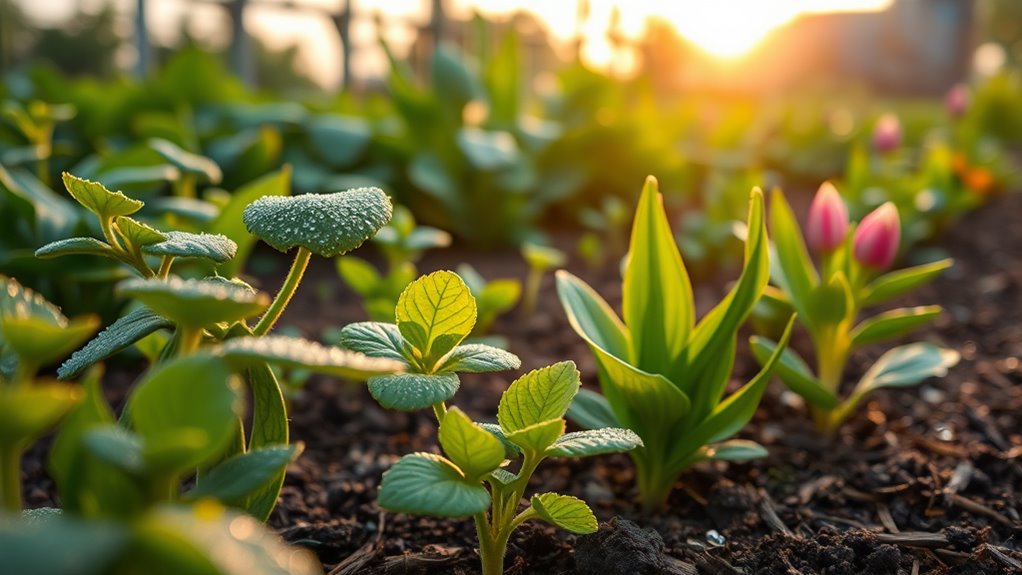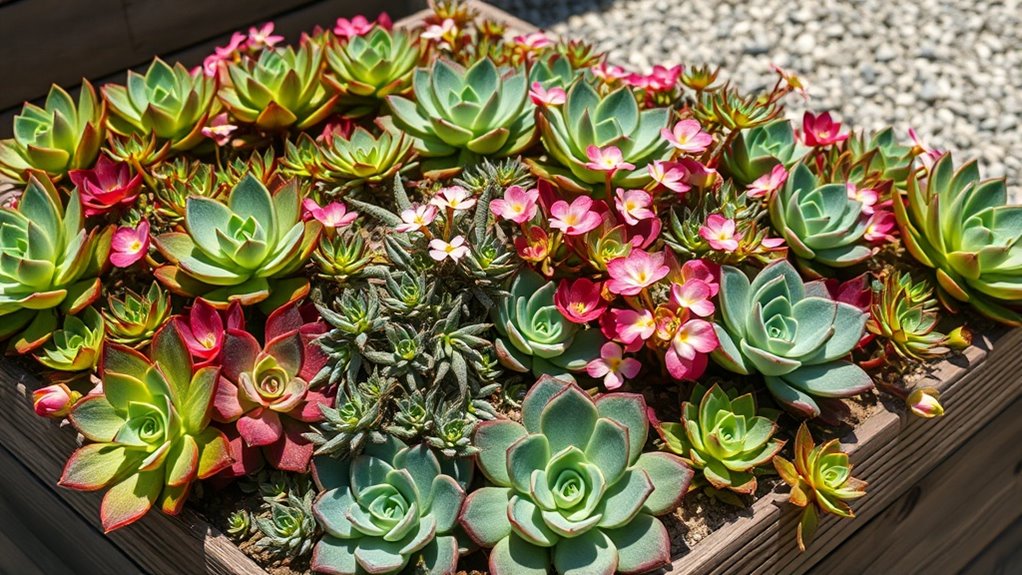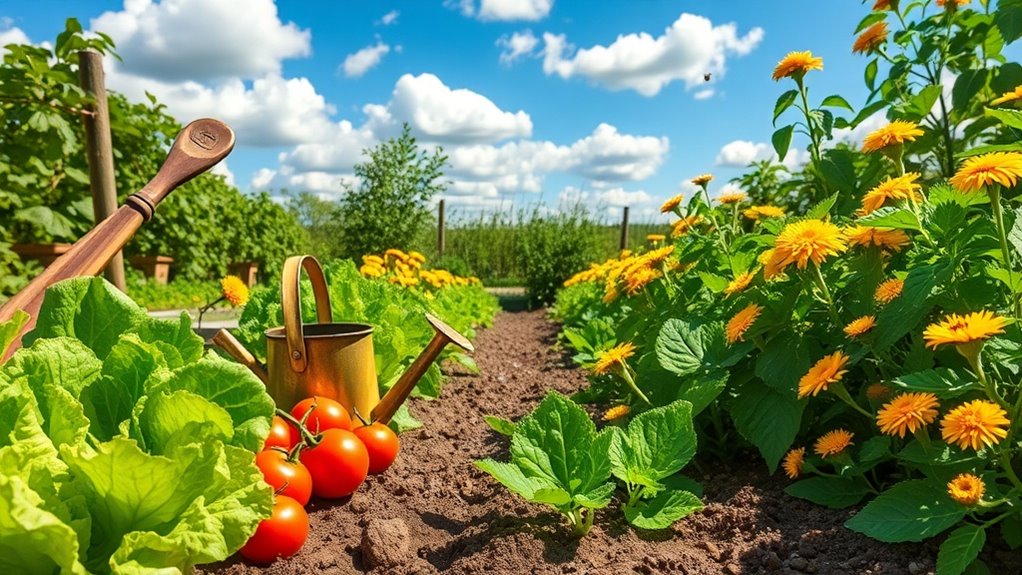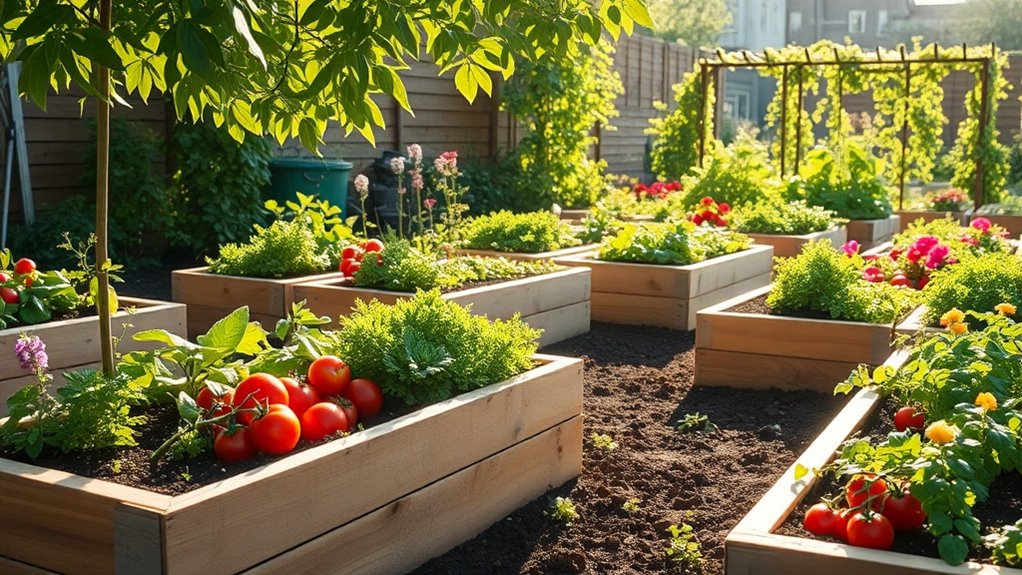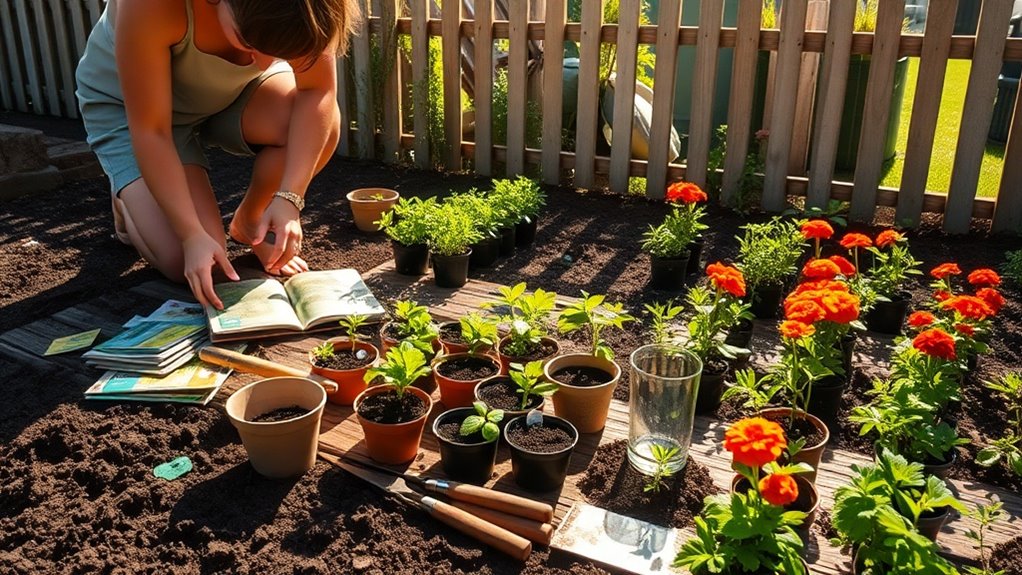How to Water Less and Grow More – It’s All About Timing
To water less and grow more, you’ll optimize your garden by timing irrigation to natural cycles. Water early mornings, from 5 to 9 a.m., when cooler temps minimize evaporation and boost root absorption, conserving water while promoting healthier plants. Adjust for seasons—extend summer intervals with mulch to retain moisture—and use soil moisture meters for precise monitoring. This scientific approach cuts waste and maximizes growth, so keep exploring these strategies for even greater garden success.
Key Takeaways
- Water early in the morning (5-9 a.m.) to minimize evaporation and maximize nutrient absorption.
- Adjust watering schedules seasonally, like reducing in winter, to match plant needs and conserve water.
- Use soil moisture meters to time watering precisely, preventing overwatering and promoting efficient growth.
- Apply mulch around plants to retain soil moisture, allowing for less frequent watering sessions.
- Choose drought-resistant plant varieties and focus on deep, infrequent watering for sustained, healthy growth.
Understanding Plant Watering Schedules
Understanding plant watering schedules helps you conserve water while maximizing growth, as overwatering often leads to root rot and wasted resources. In extreme heat, these schedules can incorporate essential tips to keep plants hydrated and thriving during scorching conditions.
Watering timing tips involve assessing soil moisture and environmental factors to create tailored schedules. You test soil dryness with a finger or meter before watering, observe plant signals like wilting, and factor in weather variability for precision.
This scientific method prevents excess moisture, fostering strong roots and efficient resource use. By applying these tips, you’re promoting healthier plants through balanced hydration, reducing waste and enhancing overall garden sustainability.
Moreover, incorporating expert watering techniques can help you steer clear of frequent errors and boost your garden’s vitality.
Best Times to Water Your Garden
Once you’ve assessed soil moisture and plant signals from your watering schedule, you’ll find that timing makes all the difference in your garden’s efficiency.
In scientific terms, early morning—ideally between 5 a.m. and 9 a.m.—is optimal, as cooler temperatures and higher humidity minimize evaporation, allowing water to penetrate deeply into the soil for better root absorption. This reduces water loss and promotes healthier growth.
For late afternoon watering, around 4 p.m. to 6 p.m., ensure foliage dries before dark to prevent fungal diseases.
Factors Influencing Watering Timing
Several factors can influence the optimal timing for watering your garden, such as weather conditions, soil type, and plant needs, which you’ll need to evaluate to minimize waste and boost growth.
Understanding these helps you make informed decisions for efficient hydration.
-
Weather conditions: Assess temperature and humidity; water on cooler, less windy days to reduce evaporation and retain moisture effectively.
-
Soil type: Test your soil’s texture—sandy soils dry out faster, requiring earlier watering, while clay retains water longer, preventing root rot.
-
Plant needs: Observe species-specific demands; drought-tolerant plants need less frequent watering than high-water users like tomatoes.
-
Evaporation rates: Measure environmental factors like sunlight intensity; irrigate when rates are lowest to ensure deeper soil penetration and nutrient uptake.
By mastering these factors, gardeners can achieve thriving gardens through optimized watering practices that promote healthier plants and sustainable water use.
Incorporating deep watering techniques can help ensure that water penetrates deeply to the roots, supporting the once-a-week watering strategy for better plant health.
Seasonal Adjustments for Efficient Watering
As you adapt your watering routine for different seasons, you’ll start with spring techniques that encourage root development using targeted, shallow applications.
In summer, you counter drought by extending intervals between waterings and mulching to minimize evaporation. Additionally, mulching supports moisture retention to enhance soil health and reduce the need for frequent watering.
Finally, for winter, you conserve moisture through reduced frequencies and protective coverings to prevent soil desiccation.
By incorporating an innovative watering schedule, gardeners can further enhance overall efficiency and productivity as outlined in proven techniques.
Spring Watering Techniques
In spring, warmer temperatures and longer days accelerate plant growth, so you’ll need to refine your watering techniques to minimize waste while maximizing yields.
With increased evaporation, focus on precise timing to support root development without excess moisture.
-
Check soil moisture: Use a probe to measure the top 6 inches daily; water only if it’s dry to avoid runoff.
-
Time your sessions: Water early mornings when temperatures are cooler, reducing evaporation by up to 50%.
-
Incorporate mulching: Apply 2-3 inches of organic material to retain soil moisture and moderate temperatures scientifically.
-
Adjust for plants: Base frequency on species needs, like lighter watering for new seedlings to promote strong growth patterns.
Summer Drought Adjustments
Summer heat intensifies evaporation and drought risks, so you’ll adapt your watering from spring’s methods to conserve resources and sustain growth.
Opt for deep, infrequent sessions—every 7-10 days based on soil type—to foster deeper roots and drought resistance. Use a soil probe to measure moisture accurately, watering only when the top 2-4 inches dry out.
Apply 2-3 inches of mulch to reduce evaporation and maintain soil temperature. Choose drought-tolerant plants and incorporate compost to enhance water retention.
Early morning or evening timing minimizes losses, promoting efficient hydration for thriving gardens.
Winter Moisture Conservation
As winter sets in with its freezing temperatures and reduced evaporation, you’ll minimize watering frequency to prevent root rot and conserve moisture effectively.
In winter, plants enter dormancy, so focus on maintaining optimal soil moisture to support recovery without waste.
-
Monitor soil moisture: Use a probe or finger test weekly to check if the top inch is dry before watering, preventing overhydration.
-
Apply mulch layers: Cover soil with 2-4 inches of organic material like straw to insulate roots and reduce evaporation rates.
-
Time watering wisely: Water in the morning if needed, allowing absorption before freezes, which minimizes ice damage.
-
Select hardy plants: Choose species adapted to cold, like evergreens, to lower overall water demands during dormancy.
Tools for Monitoring Water Needs
To monitor your plant’s water needs effectively, you’ll find soil moisture meters invaluable for directly measuring soil hydration levels and preventing overwatering.
These tools give you precise readings that guide your irrigation decisions based on actual soil conditions.
Additionally, rain gauge tools let you track precipitation accurately, helping you adjust watering schedules to conserve water and promote healthier growth.
For comprehensive garden management, incorporating soil testing can help identify soil issues that influence water retention and plant health.
Furthermore, understanding signs of overwatering is essential to avoid common mistakes that can harm your plants’ health.
Soil Moisture Meters
Soil moisture meters are practical devices that help you measure the exact water content in your soil, ensuring plants get just the right amount without waste.
They operate on scientific principles like capacitance or resistance, delivering real-time data to optimize your watering and prevent issues like root rot or dehydration.
-
Select the right model: Choose one suited to your soil type, such as a capacitive meter for clay soils, for accurate results.
-
Install properly: Insert the probe to the root zone depth, ensuring good soil contact for reliable readings.
-
Interpret data: Use the meter’s scale to determine moisture levels and decide when to water based on plant needs.
-
Maintain regularly: Clean and calibrate your meter seasonally to keep measurements precise and extend its lifespan.
Rain Gauge Tools
Rain gauge tools measure rainfall amounts, helping you gauge natural water input for your plants. You can select from basic cylinder gauges or advanced digital models that log data for easy analysis.
Install yours in an unobstructed spot to capture precise measurements, then record weekly totals to adjust your watering schedule. For instance, if rainfall exceeds 1 inch, skip irrigation to prevent overwatering.
This scientific approach reduces waste, enhances plant resilience, and integrates seamlessly with soil moisture monitoring for data-driven decisions. Remember, accurate tracking means you’re watering less while growing more efficiently.
Techniques to Reduce Water Waste
Efficient techniques let you minimize water waste in your garden while boosting plant health.
You’ll apply science-backed methods to conserve water effectively, focusing on efficiency and plant needs.
-
Use mulch layers: Apply organic materials like bark to reduce soil evaporation by up to 70%, retaining moisture without excess watering.
-
Adopt drip irrigation****: Direct water to plant roots via low-flow systems, minimizing runoff and evaporation losses by 50% or more.
-
Harvest rainwater: Collect runoff in barrels for reuse, cutting municipal water use and leveraging natural precipitation cycles.
-
Inspect for inefficiencies: Regularly check hoses and timers for leaks, ensuring precise delivery and preventing up to 20% water loss.
To further improve soil health and water retention, incorporate organic composting using kitchen scraps and garden waste.
By applying mulching, you can keep your garden consistently moist and thriving throughout the growing season.
Maximizing Growth With Minimal Watering
While water remains crucial for plants, you can boost growth by strategically selecting drought-resistant varieties and fine-tuning your watering routine to match their specific needs, drawing on scientific principles like root zone optimization and soil moisture monitoring.
To optimize, use tools such as tensiometers to measure soil moisture accurately, ensuring you water only when necessary. Focus on deep, infrequent applications that promote robust root systems, enhancing nutrient uptake.
Experiment with mulching to retain moisture and reduce evaporation, backed by studies showing up to 30% water savings. Track plant responses to refine your approach, yielding healthier yields with less waste. Additionally, enhance your soil fertility by incorporating simple ingredient swaps into your composting routine for richer, more nutrient-dense results.
To complement your watering strategy, consider adopting sustainable fertilizing methods that draw from natural ingredients to improve soil health and support overall plant vitality.

